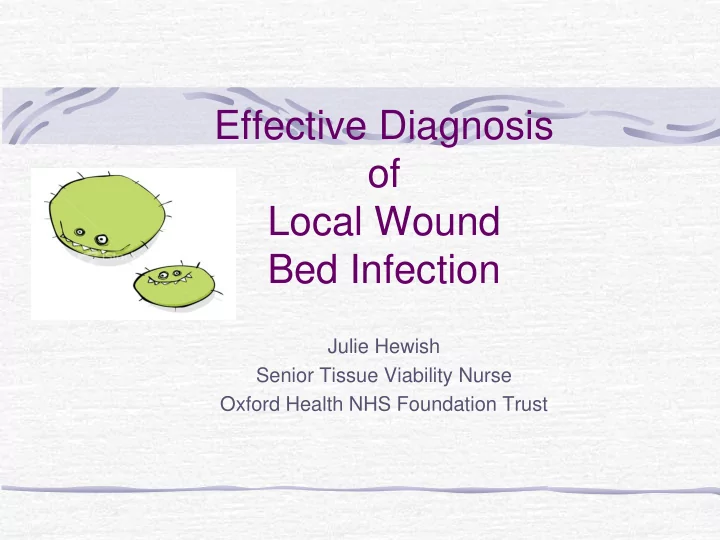

Effective Diagnosis of Local Wound Bed Infection Julie Hewish Senior Tissue Viability Nurse Oxford Health NHS Foundation Trust
Localised Wound Bed Infection is the Result of imbalance between patient’s immune system and the conditions within the wound (EWMA 2005)
“The Germ is nothing. It is the terrain in which it is found that is everything.” Pasteur 1880
Trust Guidelines Wound Infection is a clinical diagnosis Wound swabs are only indicated where systemic antibiotic therapy is required. Antibiotics should not be used in the absence of systemic/soft tissue infection.
All wound contain bacteria therefore the Challenge: recognising the signs of an increase in the numbers of bacteria – the bioburden, which may lead to infection. Timely intervention
Bacterial Balance Presence of non-replicating micro-organisms Routine wound management: Patient and Wound Bed Peri-wound cleansing currently stable. Exudate management
Contamination
Presence of multiplying micro-organisms with no Routine wound management: injury to the host Peri-wound cleansing Exudate management Healing potentially compromised Debridement Consider topical antimicrobial dressing
Colonisation
Micro-organisms are a burden Proactive approach to wound Patient experience: management: Acute Increased pain Debridement Use of antimicrobials Acute Increasing exudate levels Exudate management Antibiotic therapy Yes / No
Local Wound Bed Infection
Consider: Increased wound discharge Unexpected pain Non or delayed healing Wound breakdown Bridging of epithelium Pocketing in the wound bed Unhealthy granulation tissue: bright red, often friable, bleeding brown Granulation tissue Abscess formation Malodour
Assessment and Management of patients with Infected wounds Consider possible Assessment and systemic Consider topical Management treatments treatments of symptoms for wound for wound infection of infection infection
Wound Bed Contamination Patient’s immune system is maintaining bacteria at safe levels. Healing/patient not compromised Wound Bed Wound surface area has reduced in size by 40% at 6 weeks. Positive granulation/epithelialisation LOCAL SIGNS & Exudate Levels Normal exudate for patient / wound type SYMPTOMS Pain No change Erythema Erythema not usually present SYSTEMIC SIGNS & SYMPTOMS None Systemic No Anttimicrobials (antibiotics) MANAGEMENT High Risk Patient Wound Swabs for No 2 M, C & S Topical Standard formulary dressing Antimicrobial dressing Treat / optimise co-existing morbidities Other Actions Assess wound for critical colonisation/infection at every dressing change Debride sloughy/necrotic tissue 3
Wound Bed Colonisation Wound Bed Colonisation Multiplying bacteria has the ability to tip patient and wound defences Healing Compromised Healing has slowed / or stopped (non-progressing wound)). Sloughy/necrotic tissue may be present Wound Bed Increased exudate (sometmes mild odour) LOCAL SIGNS & SYMPTOMS Exudate Increased/changed pain Levels Pain Erythema not usually present Erythema None No SYSTEMIC SIGNS & SYMPTOMS Systemic Consider antibiotic in line with local prescribing antibiotics protocols/guidelines Wound No MANAGEMEN Swabs for T M, C & S 1 st Line Honey-impregnated dressing Antimicrobial dressing 2 nd Iodine-based dressing Consider referral to Tissue Viability Other Actions Treat / optimise co-existing morbidities Assess wound for infection at every dressing change Debride sloughy/necrotic tissue 3
Local Wound Bed Infection Local Wound Bed Infection Patient’s defences are overwhelmed Healing and patient compromised Wound Bed Healing has stopped or Wound has deteriorated / extended Exudate levels Malodour/Copious/purulent exudate LOCAL SIGNS & SYMPTOMS Pain Acute Pain/changed pain Erythema Local Wound Bed Systemic Infection Infection Erythematous Erythematous border border <2cm >2cm Pyrexia Tachycardia SYSTEMIC SIGNS & Abnormal /changed General malaise SYMPTOMS Odour Raised WBC & Discoloured/friable Tissue pocketing CRP Bridging /necrosis Soft Tissue Infection slough Systemic No Yes Antimicrobials (antibiotics) MANAGEMENT High Risk Yes Patient Wound Swabs No 2 Yes for M, C & S 1 st Line Honey-impregnated dressing Antimicrobial dressing 2 nd Iodine-based dressing Refer to Tissue Viability if support needed Other Actions Treat / optimise co-existing morbidities
Conclusion: Improve patient outcomes Need for early and accurate diagnosis of wound infection Indiscriminate use of antibiotics Increasing cost of antimicrobial dressings Careful, thorough assessment of the person with the infection Management of the symptoms of infection Reduce the risk of complications
Thank you for listening
Recommend
More recommend